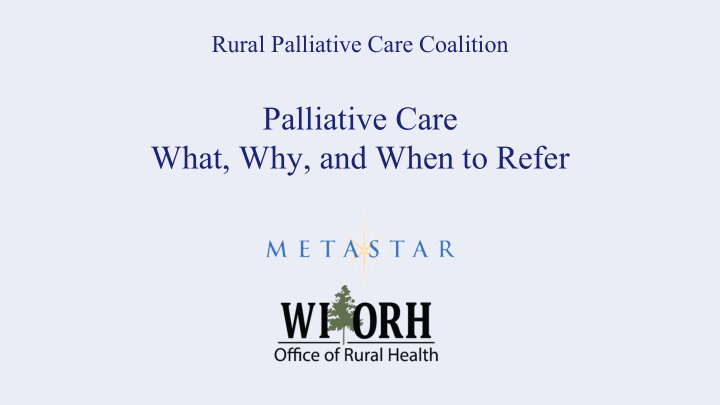



Rural Palliative Care Coalition Palliative Care What, Why, and When to Refer
What is Palliative Care • Palliative care is care focused on providing relief from the symptoms and stress of a serious illness • The goal is to improve quality of life for both the patient and the family • It addresses the medical, psychological, spiritual, and social needs of seriously ill patients and their family caregivers
What is Palliative Care • Eligibility is based on the needs of the patient, not prognosis • Any age or stage • Any serious illness • Can be provided at the same time as disease-focused, life-prolonging, and curative treatment • Provided in any setting but there is limited access outside hospitals due to the way palliative care programs are currently funded
Why Palliative Care Specialist-level palliative care - trained team of specialty doctors, nurses, and other working with the patient’s other providers to deliver an extra layer of support to meet the needs of patients and their families. Primary palliative care - primary care clinicians assisting patients and families to establish appropriate goals of care based upon the illness and trajectory in order to facilitate medical care decisions consistent with the patient's values and goals.
Most Common Chronic Conditions • Chronic Obstructive Pulmonary • Chronic liver disease Disease (COPD) • HIV/AIDS • Congestive Heart Failure (CHF) • Lupus • Cancer • Multiple sclerosis, • Dementia Parkinson’s, ALS • Stroke • Rheumatoid arthritis • Chronic Kidney Disease (CKD) • Huntington’s disease
Common Referral Reasons • Uncontrolled symptoms or suffering despite treatment attempts • Unclear goals or plan of care, or, disagreement among patient, family, or care team concerning goals and plan of care • Family and caregiver distress • Progressive functional or cognitive impairment
Patient and Family Benefits Individualized care • Symptom control (e.g., pain, shortness of breath, nausea, fatigue) • Honest discussion of disease, prognosis, care goals/preferences, patient/family values • Connection to community supports and resources • Spiritual support • Coordination of care amongst patient’s care teams The outcome is a care plan, including an advance care plan, based on goals and priorities of the patient
Difference Between Hospice and Palliative Care • Hospice is restricted to the end of life (estimated prognosis of less than six months) for eligible patients and their families, and includes robust interdisciplinary care bereavement care after death • Patients are not automatically enrolled, they must choose this option • Hospice is a structured insurance benefit provided by most public and private insurers but the patient must agree to give up insurance coverage for disease-focused, life-prolonging treatment
Resource: http://www.thehastingscenter.org/pdf/living-long-in-fragile-health.pdf
Case Study: Mr. Miller 93 year old male with a past medical history CHF Stage 3, COPD, Spinal Stenosis, DDD, HTN, Elevated PSA, Calculus of Kidney, OSA with CPAP use, OA of right knee with a Clindamycin allergy was as requested to be seen by Palliative care after he requested no further hospitalizations or treatments. Primary care provider (PCP) would like more in depth discussions on goals of care.
Mr. Miller • His goal: stay at home with his cat • Although he was supported by all three of his children, desires to live alone • Has had increasing shortness of breath (SOB) but could manage at home when assessed initially • Palliative care followed for a year and during that time, Mr. Miller had two CHF exacerbations and one COPD exacerbation
Mr. Miller • Noted to have mild increase in confusion and PC re- assessed in his home • Increased lung rales • Increased edema in lower extremities. • Lasix increased after discussion with patient/family and PCP • Goal included no labs so Potassium was adjusted but level not checked • Improved and was able to maintain in home
Mr. Miller • Three months later had increased SOB thus exam by PC NP • O 2 sats 78 percent with walking desat test • Increased wheezing and respiratory effort • Collaborated with PCP and order for O 2 and nebulizer • Prednisone burst • Symptoms improved within 2-3 days and continued to maintain at home with family support
Mr. Miller • Nine month PC reassessment • Ensure initiated due to progressive weight loss resulted in rebound but then trended downward • Increased overall weakness and increased SOB and as disease progressed, manage SOB with low dose liquid morphine • Increase in Lasix but SOB and decreased activity tolerance continued • Anxiety increased thus started on Sertraline and titrated and helped initially
Mr. Miller • Over the next two months: • falls increased as continued to become weaker • Breathing difficult managed with modifications in activities and medications to maintain comfortable • Continued weight loss • After discussed overall goals of care, was referred to hospice for greater level support in the home
Key Take Aways • Importance of early conversations of goals of care, home support, and assessment within the care setting • Having plan of care, including pharm and non pharm interventions when symptoms escalate • Clear communication with all members of medical team (i.e., Pulmonology, Cardiology, PCP) • Discussion of risk factors
Questions?
Contact Details Name Organization Full address E-mail address Phone
Recommend
More recommend